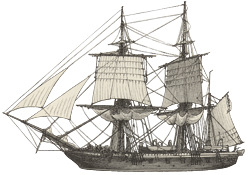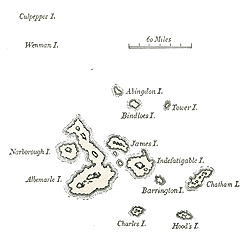
HMS Beagle in the Straits of Magellan, in Charles Darwin, Journal of researches, 1890 edition
Origins of the Origin
Darwin and the Beagle Voyage continued
Darwin’s career in natural history continued at Cambridge; he fell in with naturalist John Stevens Henslow (1796–1861), Regius Professor of Botany, who published A Catalogue of British Plants in 1829, during Darwin’s tenure at university. After graduation in summer 1831, Darwin accompanied Adam Sedgwick (1785-1873), the Woodwardian Professor of Geology, on a field survey of North Wales. And then in December, mind prepared and skills of observation sharpened, he was off on the Beagle.
The Beagle voyage provided Darwin with continuous revelations— geological, zoological, and anthropological—from fossil mammals in Argentina to earthquakes in the Andes to platypuses in Australia. Most famous was his investigation of the natural history of the Galápagos Islands, off the coast of Ecuador. On each of the 16 islands, the flora and fauna seemed adapted to the microclimate of each island—and the animals, while seemingly related to one another, were yet quite distinct. Only after Darwin’s return, when the specimens could be studied, would ornithologist John Gould (1804–1881) determine that the Galápagos birds that Darwin had thought to be a mixture of species, were in fact all types of finches.

Galápagos archipelago, in Charles Darwin, Journal of researches, 1902 edition
On the Beagle, Darwin deepened his knowledge of geology by reading Charles Lyell’s Principles of Geology, then being published. Lyell (1797-1875) proposed that small physical actions, acting over immense stretches of time, could give rise to large geological changes. The work championed a new way of doing “historical sciences” such as geology: inductive reasoning from known forces extending back over time. Lyell’s ideas found strong support in John Herschel (1792–1871), the dean of English science; in a famous exchange of letters, these scientists speculated that the method might be used to explain the extinction of older species and “origination” of new ones—though they had no specific idea how this might work. Darwin’s work on the Beagle put him right into the midst of this ongoing ferment of ideas. In June 1836 Darwin landed at the Cape of Good Hope and visited astronomer Herschel, who was there mapping the southern heavens. Darwin corresponded with Lyell on coral atolls and the rising of continents.
Last Reviewed: January 25, 2024


